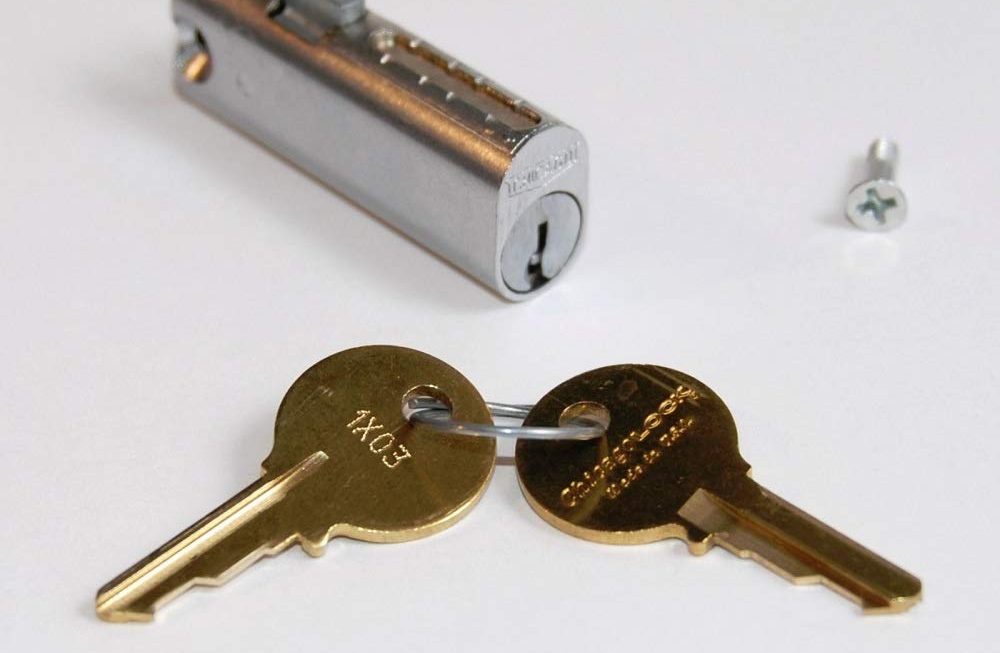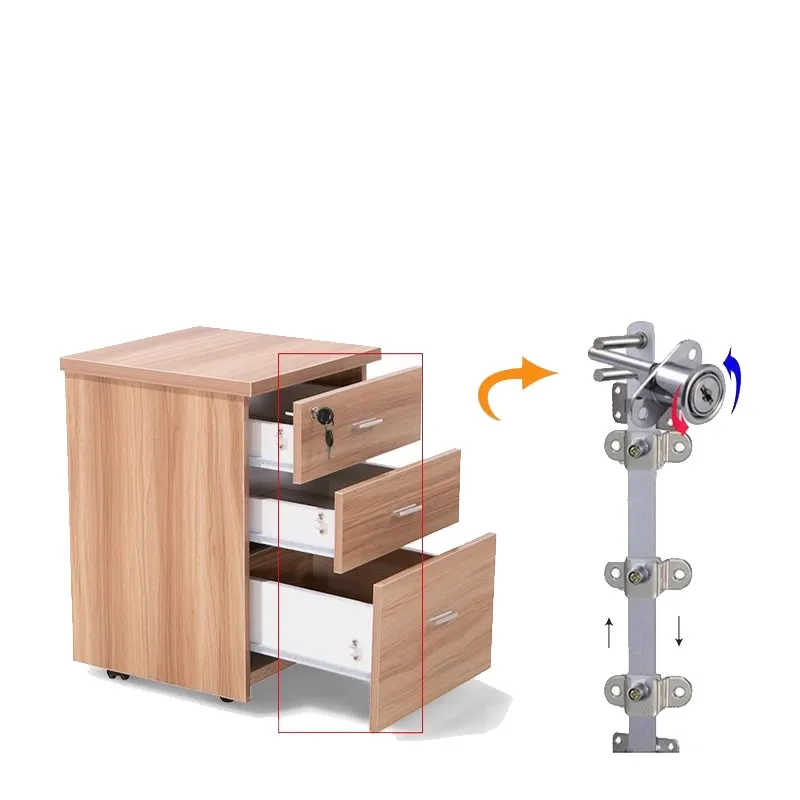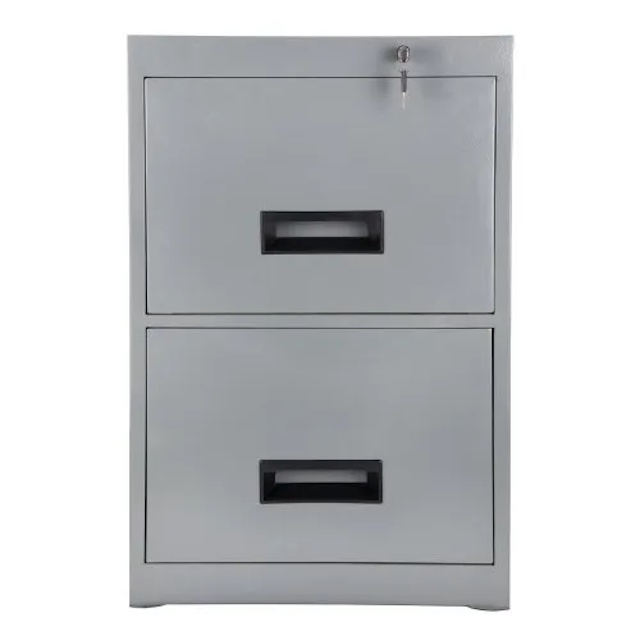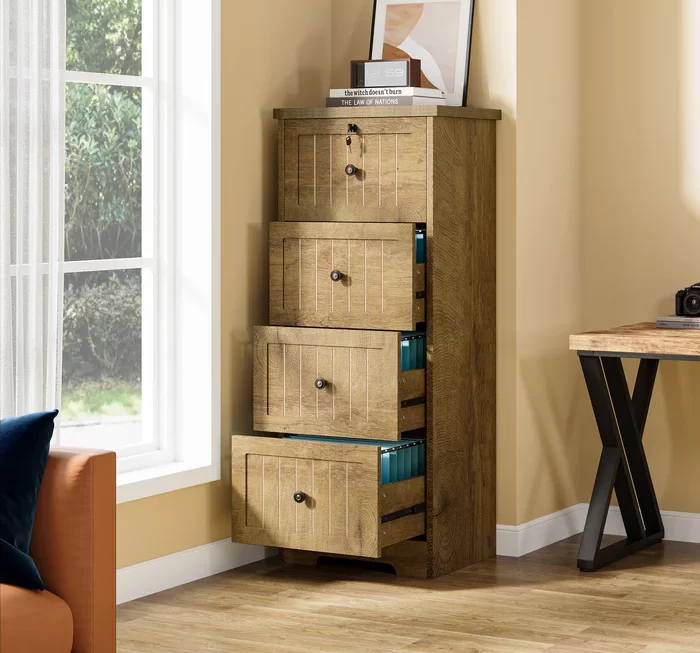Types of Filing Cabinet Locks
Choosing the right type of filing cabinet lock is essential to ensure the security of your documents. Here, we’ll go through the common types of filing cabinet locks, which provide different levels of security and accessibility.
Cam Locks
Cam locks are among the most widespread types of cabinet locks. They feature a rotating bar (the cam) that turns as the key rotates. These locks are suitable for standard filing cabinets that require a basic level of security. They’re easy to install and operate, and they’re also a cost-effective option if budget is a concern.
Plunger Locks
Plunger locks work by pushing a locking rod down into the frame of the cabinet. They often come with a push-to-lock mechanism, making them convenient as there’s no need to turn a key to secure the cabinet. This can be a quicker option for locking multiple drawers at once, useful for busy office environments.
Electronic Locks
Electronic locks provide a higher level of security. Many come with features such as keypads or card swipes, allowing for keyless entry. They might also include audit trails or timed access settings, which can deter unauthorized access and monitor usage. They are ideal for filing cabinets storing sensitive or confidential information.
Incorporating the keyword ‘filing cabinet locks’ effectively, we have outlined the main options available when looking to secure document storage cabinets. Remember, the choice of lock will depend on the level of security required and the ease of use desired.
Choosing the Right Lock for Your Filing Cabinet
When looking for the best filing cabinet locks, you need to weigh several key factors.
Factors to Consider
Think about what you’ll store in the cabinet. Is it sensitive info, or just everyday paperwork? Also consider how often you’ll access the files. This will affect your choice. Pick a lock that matches your security needs and your daily workflow.
Security Level
Cam locks offer basic protection, good for low-risk items. Plunger locks add convenience with push-to-lock tech. For high-security needs, like confidential files, go for electronic locks. They have advanced features to keep out unauthorized users. The more sensitive the documents, the higher the security level you should aim for.
Ease of Use
The best lock is one you’ll use properly every time. If you’re always in a hurry, a complex lock might get ignored. Cam and plunger locks are simple and fast. Electronic locks need no key, just remember the code or have the card. Think about who else needs access. Keyless options can make this simpler.
Installation Tips for Filing Cabinet Locks
Installing the right filing cabinet locks is crucial, but proper installation is equally important for ensuring the effectiveness of your security measures. Below are tips and tools you’ll need for a smooth installation process.
Tools Required
Before starting the installation, gather these tools:
- A drill for making pilot holes, if necessary.
- A screwdriver, matching your lock’s screws.
- A measuring tape to align the lock correctly.
- Pen or pencil for marking drill spots.
- Possibly a hammer, for some lock types.
Ensure you have all these tools on hand to avoid disruptions during the installation process.
Step-by-Step Installation Guide
- Measure the area where the lock will go. Mark it with your pen or pencil.
- If your lock needs pilot holes, use the drill to create them.
- Position the lock onto the cabinet, aligning it with the marks.
- Use the screwdriver to fasten the lock into place with screws.
- Test the lock to make sure it secures the drawer or cabinet door tightly.
- Repeat the steps for each lock you need to install.
By following this simple guide, you can ensure your filing cabinet locks are installed correctly, providing you with the security you need for your documents.
Maintenance and Care for Cabinet Locks
To keep your filing cabinet locks functioning well, regular maintenance is key.
Regular Checkups
Schedule checkups for your locks every few months. During checkups, test keys and mechanisms to ensure smooth operation. If you face difficulty turning the key or the lock sticks, address it promptly.
Dealing with Rust and Wear
Moisture and time can lead to rust and wear on metal locks. If you notice any rust, apply a suitable lubricant. For electronic locks, check for battery corrosion and replace batteries regularly. Wipe down the locks with a dry cloth to prevent moisture build-up.
Cleaning and maintaining cabinet locks can extend their life, preventing unexpected failures that can compromise your document security. Be proactive in caring for your locks.
Advanced Security Features
For top-level security, advanced features in filing cabinet locks are a must. They adapt to tech trends and provide superior protection.
Keyless Options
Keyless locks boost security with no need for physical keys. They often use keypads, cards, or fobs for access. No key means fewer risks of loss or theft. They are ideal for offices with high traffic or where multiple people need access. Codes or access tools can be changed or updated as needed.
Biometric Access
Biometric locks use fingerprints or other unique personal identifiers for access. They ensure that only authorized individuals can open the filing cabinet. This tech is cutting-edge and the most secure. It’s perfect for storing highly confidential or sensitive documents. They are quick to unlock and leave no room for key copying or sharing.
Emergency Access and Lock Overrides
Even with the best filing cabinet locks, emergencies can happen. Lost keys or lock malfunctions may require immediate access to your documents.
Lost Key Solutions
When you lose a key to your filing cabinet, don’t panic. Consider these solutions:
- Check for a master key. Many filing cabinets come with one.
- Contact the manufacturer. They can sometimes provide a replacement key.
- Reach out to a locksmith. They can craft a new key or unlock the cabinet.
Always keep a spare key secure, and note down the lock’s serial number for replacements.
Breaking a Stuck Lock
If your lock is jammed and you can’t wait, you may need to break it open. Here’s how:
- Use a drill to destroy the lock cylinder. Be mindful of the cabinet’s integrity.
- Tap the lock with a hammer gently to break a weak or rusty one.
- Employ a lock-picking set if you have the skill. This method is less damaging.
Remember, breaking a lock should be a last resort. Afterward, install a new lock promptly.
Best Practices for Keeping Documents Safe
Securing filing cabinet locks is vital, but it’s just one part of keeping documents safe. The way you organize and take additional steps can help increase security.
Organizational Tips
Good organization makes it harder for unauthorized access and easier to spot irregularities. Here’s what you should do:
- Label each drawer clearly. This helps you find files fast and notice if something is out of place.
- Create a filing system based on access levels. Store highly confidential files separately.
- Limit access for sensitive files to only those who must use them.
- Conduct regular audits on file usage and cabinet access to track any unusual activity.
- Always ensure cabinets are locked before leaving the office.
Organized systems help you keep track of documents and ensure that only authorized people access them.
Complementing Locks with Other Security Measures
Add layers of security beyond just locks:
- Install CCTV cameras in document storage areas. They can deter theft and help identify intruders.
- Use alarm systems that notify you of unauthorized access attempts.
- Implement a sign-in sheet or digital log for document access, to keep a record of file usage.
By combining organizational techniques and additional security measures, you create a robust system. This not only secures your documents but also makes managing them more efficient.






